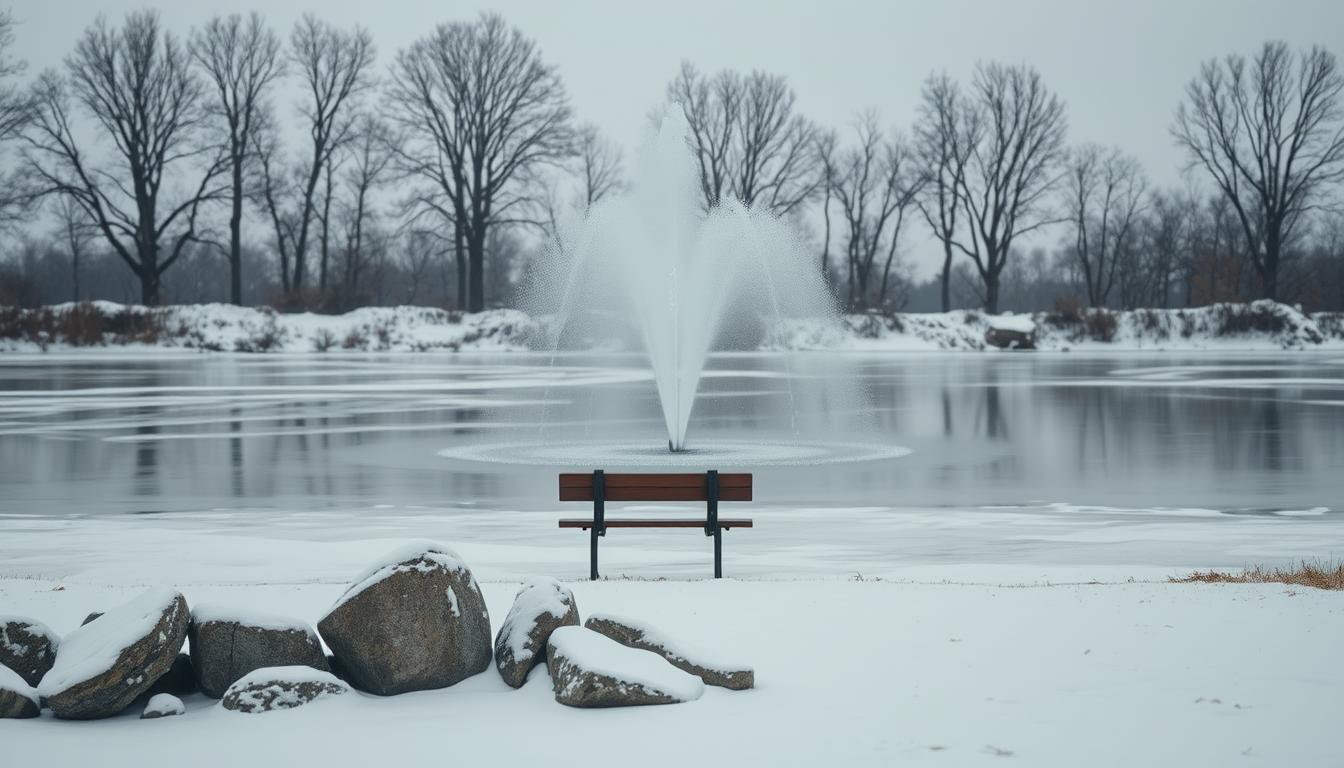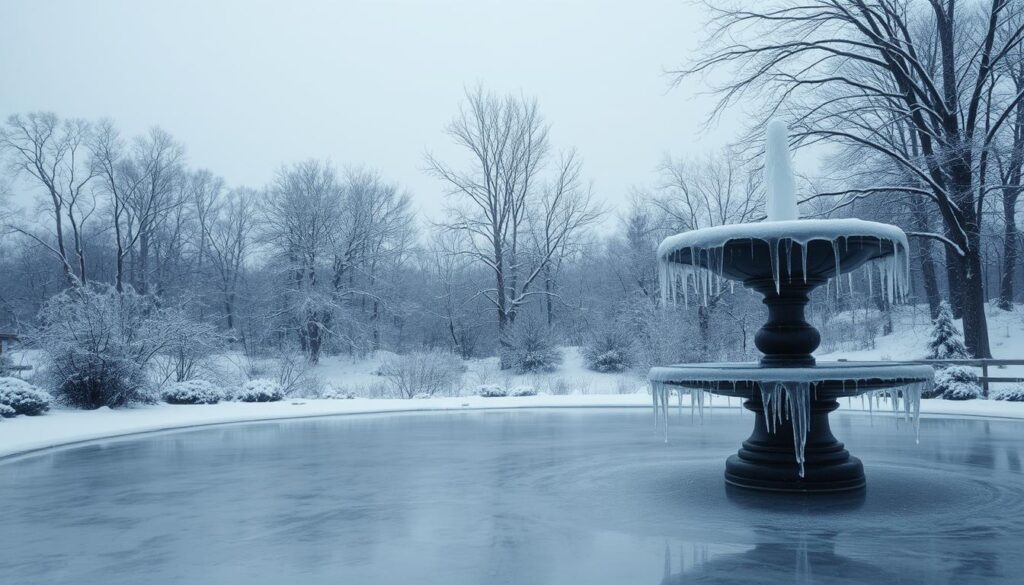
Protecting outdoor features starts with timing. Freezing water expands and can crack a fountain body or ruin the pump. Begin work in late autumn, before the first steady below-freezing nights, so you can finish draining and disassembly without rush.
Power down and remove all electrical parts. Completely drain basins, disassemble accessible pieces, and clean with mild dish soap. Use vinegar or baking soda to remove mineral scale, but avoid vinegar on copper patina.
Do not add antifreeze. It’s toxic to pets, wildlife, and children and can damage pumps. Small units should be stored indoors in a dry, frost-free spot. Large pieces stay outdoors only if covered with a breathable fitted cover and packed with towels or burlap to absorb moisture.
For pond-mounted units, pull them in by mooring lines, inspect cords for nicks, cap connectors, and keep a diffuser running to maintain gas exchange through the months ahead.
Key Takeaways
- Start winterizing in late autumn to prevent freeze damage.
- Drain, disassemble, clean, and dry every component thoroughly.
- Never use antifreeze; it poses safety and mechanical risks.
- Store small units indoors; use breathable covers and moisture pads for large pieces.
- Inspect cords and protect connectors on pond units; maintain aeration if needed.
Prep Before Freezing Temperatures: Timing, Tools, and Safety
Start prepping your outdoor water features when forecasts predict a run of nights at or below 32°F. Begin in late autumn so you have time to gather tools and finish tasks before sustained freezing temperatures set in.

When to start
Watch local forecasts and pick a clear time in late autumn. That time gives you breathing room to work without rushing on the first cold night.
Tools and materials
- Breathable fitted fountain cover (avoid plastic)
- Absorbent towels or burlap for each basin
- Shop vac for deep bowls, soft brush, and mild dish soap
- Vinegar or baking soda for scale—test on a small area first
Safety first
Power off and unplug at the GFCI before you touch cords or the pump. Inspect lines for nicks or chew marks and plan repairs or protective sleeves if needed.
Indoors vs outdoors storage
Small units do best in a dry, frost-free garage or basement. For larger pieces left outside, elevate them, add towels in basins, and use a breathable fountain cover. Secure the hem to stop pooling and wicking.
If you prefer not to DIY, a local landscape team can handle draining tubing and checking stoppers as an option.
Winter Fountain Care Steps for Outdoor Water Features
First, shut off electrical power and verify connections are dead before touching water or parts. Unplug and completely drain every bowl and cavity. Remove drain plugs and use a shop vac for hidden water so tiny amounts don’t freeze and expand into cracks.

Disassemble and store the pump
Take apart accessible tiers, bowls, and tubing. Remove the pump and bring it indoors to a dry spot. Dry each piece thoroughly to prevent freezing cycles from causing damage.
Clean surfaces and treat scale
Wash grime and algae with mild dish soap and a soft brush. For mineral scale, test a small area first, then use diluted vinegar or baking soda as needed. Avoid vinegar on copper patina to protect finishes.
Prepare if the unit stays outside
Elevate the base off the ground and line each basin with towels or burlap to absorb residual moisture. Fit a breathable, fitted fountain cover and secure the hem so wind and snow don’t pool and wick inside. Never use plastic.
What not to do: Do not add antifreeze or run the unit in cold temperatures; these choices can cause pump failure and harm wildlife, pets, or children. After the first few freezes, check the cover and remove any snow load.
Pond Fountain and Pump Maintenance Through Winter and Into Spring
Gently reel the pond unit to shore using the mooring lines and place it on blocks off the ground for a safe inspection. This step speeds spring setup because you can leave stakes in place while you work.
Clean components while they are still wet to remove algae, mineral film, and debris that can insulate the motor. Cleaning while wet also exposes worn seals and small cracks before they cause bigger damage.
- Inspect the pump cord along its full length for nicks or chew marks; add a stainless or PolyFlex sleeve where needed.
- Protect power connections by capping ends or covering with a plastic bag to block debris during storage.
- Complete off-season fountain maintenance now—oil, replace seals, and label hardware for quick spring reinstall.
- Store the unit in a dry, frost-free garage or basement and set it on blocks; avoid ground-level puddling that harms electronics.
- Keep diffused aeration running in the pond to keep a hole in ice and allow gas exchange; this helps preserve fish and plant health until spring temperatures rise.
When spring returns, reverse the steps: inspect, reconnect mooring lines, and test flow before full operation. If you prefer, a local landscape team can assist with reinstall and final checks.
Conclusion
Wrap up work by confirming each basin, pump, and connector is dry and stored or covered.
Drain, clean with mild soap, and dry every component to control moisture and prevent cracks. Use vinegar or baking soda carefully on scale and avoid harsh shortcuts that can cause damage.
For pond setups, pull the unit, protect cords and connectors, and keep aeration running so fish and plants fare well through the cold months.
Choose the best option for your piece: moving a water fountain indoors gives maximum protection, while a covered outdoor fountain works for large, immovable items. If you prefer help, a landscape pro can handle storage and checks.
Plan early in late autumn so spring setup is a simple restart, not a repair project.








